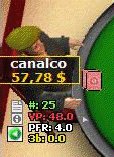Member Comments
No comments so far
 Everyone knows that a poker tracking program and HUD are great tools to help a player make better decisions during live play, but for those who have not used those tools in the past, it’s not easy to know why this is. In this article, I will go through a hand in the pre-flop stage and explain how you can use Poker Office to make your decisions easier and more accurate.
Everyone knows that a poker tracking program and HUD are great tools to help a player make better decisions during live play, but for those who have not used those tools in the past, it’s not easy to know why this is. In this article, I will go through a hand in the pre-flop stage and explain how you can use Poker Office to make your decisions easier and more accurate.
Choosing Your Statistics
In this particular hand, I will use three very commonly used statistics:
VPIP (Voluntarily Put Money into the Pot)
PFR (Pre-Flop Raise%)
3bet Pre-Flop (Re-Raise% Pre-Flop)
When I describe a player’s statistics, I will list VPIP first, PFR next, and 3bet last. To avoid including too many complex parameters, all of the players in the example hand have stacks of 100 big blinds.
Live view of chosen Poker Office statistics:

Hand Analysis Example
Hand #1 – Blinds: $0.50/$1
SB (small blind)
BB (big blind)
UTG (under the gun)
MP (middle position)
CO (cutoff)
BTN (button)
Pre-Flop: ($1.50) We’re BB, holding 8c-8d
UTG folds
MP folds
CO (35/7/2) raises to $4
BTN calls $4 (24/16/8)
SB folds
What’s our play?
Evaluating our Opponents’ Statistics
The player in the CO has put in a normal-sized raise and the player on the button has decided to call. We’re holding 8c-8d, a fairly strong pocket pair that we should definitely consider 3betting in a situation such as this one. However, let’s first consider what kind of opponents we’re facing by looking at their statistics:
CO has a VPIP of 35%, which means he plays a lot of hands, for example A4o+, most suited connectors, likely all pairs, and all Broadway hands. The player’s PFR% is 7%, which is quite tight, hands such as 88+, ATs+, KTs+, and AQo+ are expected to make up a big part of his raising range. Since CO raised, we should assume he is likely holding a strong hand.
BTN has a VPIP of 24%, which is quite a bit lower than CO’s. Hands that are likely included in a 24% VPIP range are A9o+, all pairs, QTo+, JTo, suited connectors, KTo+, and most suited aces. It’s important to note that BTN’s 3betting% is 8%, meaning that it’s much less likely that he’s calling a raise with hands such as 88+, AJo+, and KQs since those are hands he would normally 3bet with, especially in late position.
Deciding What to Do
We now have to decide if we should fold, raise, or call. Which is the correct decision based on the available information? Let’s have a look at the different options:
Fold
We hold a good pocket pair. However, it’s not always easy to play it in a multi-way pot, especially since both of our opponents have position on us. We do know that if no face cards fall on the flop, we’re often in good shape and, most of all, we know that a set has the potential to get paid off well. Remember, CO will often hold a big hand that he might have problems releasing. All in all, folding is not very attractive in this spot.
Raise
Raising is certainly an interesting option in this spot. There is a raise and a call in front of us, which means that we potentially could win an uncontested pot of 9.5 big blinds. Also, the player on the button is often holding a weak hand since he just called pre-flop, so he might put us on a very big hand and call to try and catch his hand on the flop, which he most often will not do and he will instead be forced to fold to a continuation bet from us. The problem with a raise is that CO likely holds a strong hand and, because of this, we’re over-playing our hand by raising.
Call
The big disadvantage with a call is that both of our opponents have position on us, which makes our hand much tougher to play post-flop. However, on a flop with low cards, we are often in good shape and can take a medium-sized pot down. Also, as stated above, we still have the possibility of hitting a set and taking down a big pot should one of our opponents have a strong holding.
I hope this article has given you some ideas of how to use Poker Office and its statistics to your advantage during live play.
This article was written by Poker Office. Check out PokerSoftware’s Poker Office review.
No comments so far